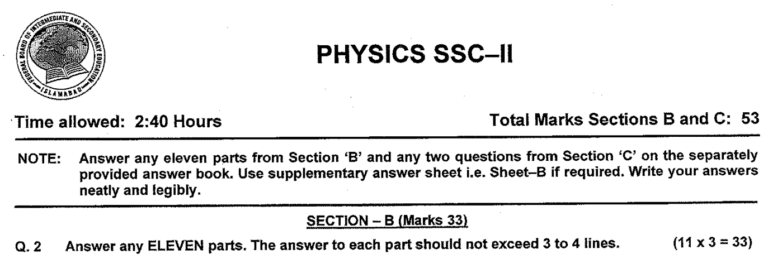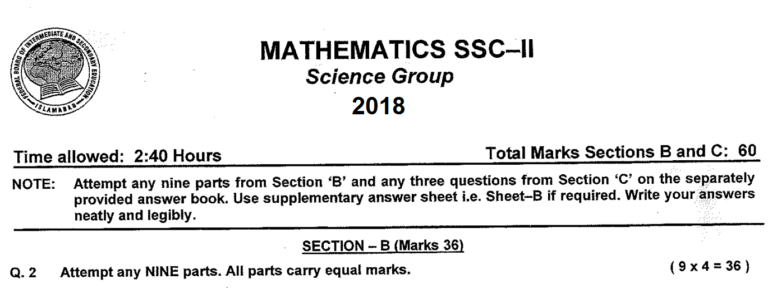Class 10 Physics 2019 Overseas Solved Past Paper Federal Board
Class 10 Physics 2019 Overseas Paper
Federal Board FBISE Class 10 Physics 2019 Overseas Paper is solved for you in this post. For more Class 10 Solved Papers visit our Class 10 Solved Papers Page.
Class 10 Physics 2019 Overseas
Section A
Q1. MCQs
Class 10 Physics 2019 Overseas
Section B
Q2.
(i) Derive a relationship between speed, frequency, and wavelength of a wave. Write a formula for the speed of a wave to its time period and wavelength.
Ans. A wave is a disturbance in a medium that travels from one place to another and hence has a specific velocity of traveling. This is called the velocity of a wave which is defined by
Velocity = distance/time
v = d / t
If the time taken by the wave is moving from one point to another is equal to its time period T, then the distance covered by the wave will be equal to one wavelength, hence we can write:
v = λ / T —– (i)
But time period T is reciprocal of the frequency f, i.e. T= 1 / f
Therefore, v = f λ —– (ii)
Eq (ii) is the relationship between the speed, frequency, and wavelength of a wave. Whereas eq (ii) is the formula for the speed of a wave to its time period and wavelength.
(ii) If the pitch of the sound is increased, what are the changes in the following?
a) Frequency
b) Wavelength
c) The amplitude of the wave
Ans.
a. Frequency: If the pitch of the sound is increased, its frequency is also increased because
Frequency ∝ Pitch
b. Wavelength: If the pitch of the sound is increased, its wavelength is decreased because
Wavelength ∝ 1 / Pitch
c. The Amplitude of the Wave: If the pitch of the sound is increased, the amplitude of the wave does not change because amplitude does not depend on the pitch.
(iii) With the help of a ray diagram, how can you show the use of a thin converging lens as a magnifying glass?
Ans. A converging lens (convex lens) can be used as a magnifying glass to produce magnified images of small objects. The object is placed nearer to the lens than the principal focus such that an upright, virtual and magnified image is seen clearly at 25 cm from the normal eye.

(iv) With the help of an electroscope how can you find the presence of charge on a body?
Ans. Detecting the Presence of Charge
In order to detect the presence of charge on anybody, bring the body near the disk of an uncharged electroscope. If the body is neutral there will be no deflection of the leaves. But if the body is positively or negatively charged, the leaves of the electroscope diverge. For example, if the body is negatively charged then due to electrostatic induction, a positive charge will appear on the disk while a negative charge will appear on the leaves. The leaves of the electroscope repel each other and diverge because each leave gets a similar charge. The divergence of leaves will depend on the amount of charge.
(v) Define kilo Watt hour (kWh) and prove that 1kWh = 3.6 MJ
Ans. The amount of energy delivered by a power of one kilowatt in one hour is called kilowatt-hour.
One kilowatt-hour 1 kWh = 1000 W x 1 hour
= 1000 W x (3600 s)
= 36 x 105 J
1 kWh = 3.6 M J
(vi) What are the factors which affect the magnitude of the emf induced in a circuit by a changing magnetic field?
Ans. The magnitude of induced e.m.f. in a circuit depends on the following factors:
1. Speed of relative motion of the coil and the magnet
2. Number of turns of the coil
(vii) What are the three universal Logic Gates? Give their symbols and truth tables.
Ans. The three universal logic gates are AND gate, OR gate, and NOT gate.
AND Gate: The electronic circuit which implements the AND operation is known as the AND gate. The symbol and truth table of AND gate is given below:

OR Gate: The electronic circuit which implements the OR operation is known as the OR gate. The symbol and truth table of the OR gate is given below:

NOT Gate: The electronic circuit which implements the NOT operation is known as the NOT gate. The symbol and truth table of NOT gate is given below:

(viii) What are the components of information technology? Clearly indicate a function of any three components.
Ans. Following are the five components of information technology:
1. Hardware: The term hardware refers to machinery. This includes the central processing unit (CPU), and all of its support equipment.
2. Software: The term software refers to computer programs and the manuals that support them.
3. Data: Data are facts and figures that are used by programs to produce useful information. It may be in the form of text,
graphic or figure that can be recorded and that has a specific meaning.
4. Procedures
5. People
(ix) Complete the given nuclear reaction; does this reaction involve fission of fusion? Justify your answer.
Ans. The complete reaction is:

The above reaction is a fission reaction because in this process a heavy nucleus breaks into two nearly equal parts with the release of large energy.
(x) The time period of a simple Pendulum is 2s. What will be its length on earth le? What will be its length on the moon lm if gm=ge/6 (Take ge=10ms-2 )
Sol. Time period of simple Pendulum = t = 2 s
Gravitational acceleration on Earth = ge= 10 ms-2
Gravitational acceleration on Moon = gm = ge / 6 = 10/6 = 1.67 ms-2
Length of Pendulum on Earth = le = ?
Length of Pendulum on Moon = lm =?
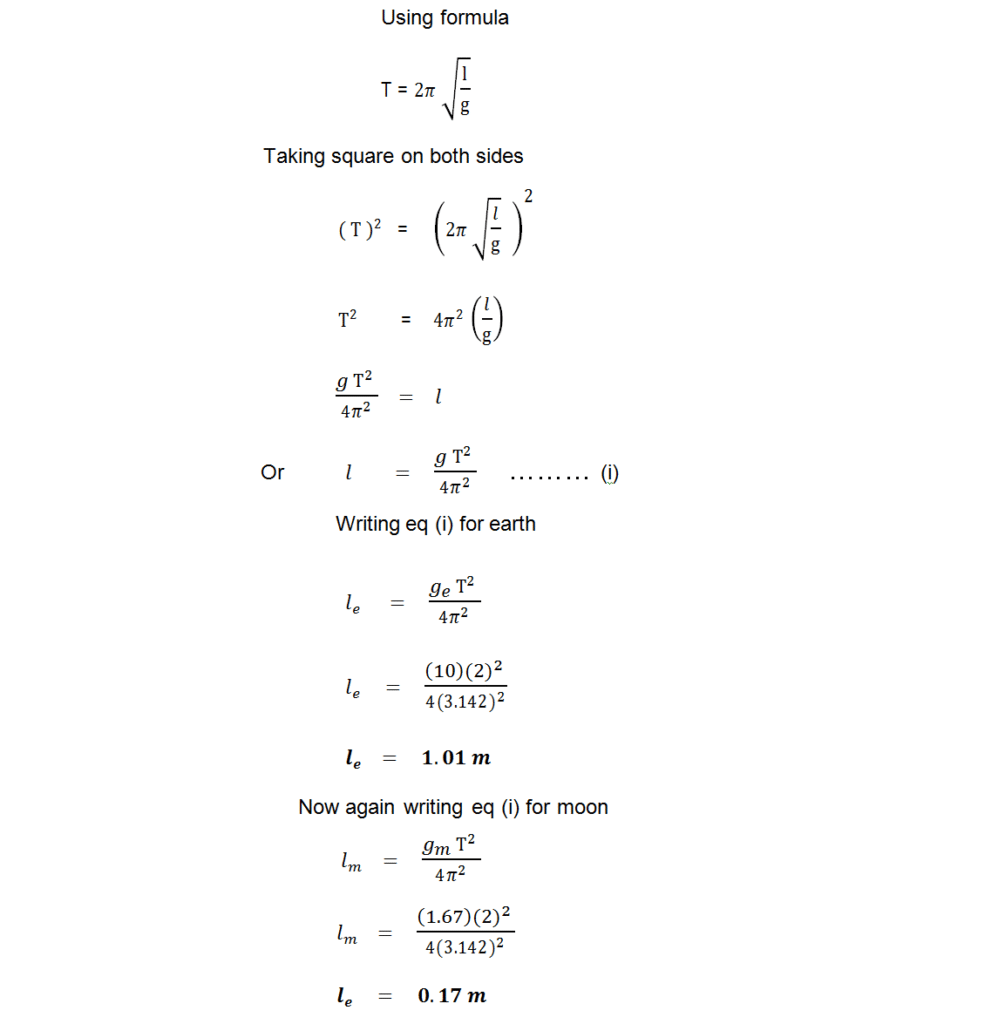
(xi) If at Anarkali Bazar Lahore, the sound level is 80 dB, what will be the intensity level of sound there?

(xii) When an object is placed between F and 2F in front of a converging lens, then at what position the image is formed? Whether the image is real and inverted or virtual and erect, magnified or diminished. Draw a ray diagram to show its image formation.
Ans. When an object is placed between F and 2F in front of a converging lens, then its image is formed beyond 2F. The image will be real, inverted, and magnified.

(xiii) How does electrostatic induction differ from charging by friction?
Ans. In electrostatic induction, a neutral object is charged with the help of a charged object whereas in charging by friction both the objects being charged are neutral.
In electrostatic induction object being charged always acquires an opposite charge whereas in charging by friction, both objects acquire the same or different charges depending upon the materials of the objects.
(xiv) A current of 3 mA flowing through a wire for 1 minute. What is the charge flowing through the wire?
Sol. Current = I = 3 mA = 3 x 10-3 A
Time = t = 1 minute = 60 s
Charge = Q =?
Using formula
Q = I x t
Q = (3 x 10-3) (60)
Q = 180 x 10-3 C
Q = 180 mC
(xv) Suppose you have a coil of wire and a bar magnet. Describe how you could use them to generate an electric current.
Ans. If we have a coil of wire and a bar magnet then we can use them to induce an electric current by moving a magnet into or out of the coil.
When the magnet is stationary, no current is induced. When the magnet is moved towards the coil, the needle of the galvanometer deflects towards the right, indicating that a current is being induced in the coil. When the magnet is pulled away from the coil, the galvanometer deflects towards the left, indicating that the induced current in the solenoid is in the opposite direction.
Class 10 Physics 2019 Overseas
Section C
Attempt any Two Questions
Q3. a. Explain series and parallel combinations of resistances with diagrams. Find the expressions for their equivalent resistances. (3+3)
Ans. Series Combination of Resistances:
In a series combination, resistors are connected end to end and the electric current has a single path through the circuit. This means that the current passing through each resistor is the same.

Expression for Equivalent Resistance:
The sum of the voltage drops across the individual resistors is equal to the voltage rating of the battery.
V=V1+V2+V3
V=IR1+IR2+IR3
V=I(R1+R2+R3)
Put V=IRe in the above equation
IRe = I(R1+R2+R3)
Thus Re = R1+R2+R3
Parallel Combination of Resistances:
In parallel combination, one end of each resistor is connected with the positive terminal of the battery while the other end of each resistor is connected with the negative terminal of the battery. Therefore, the voltage is the same across each resistor which is equal to the voltage of the battery i.e.,
V=V1=V2=V3

Expression for Equivalent Resistance:
In a parallel circuit, the total current is equal to the sum of the currents in various resistances i.e.,
I=I1+I2+I3 …… (i)
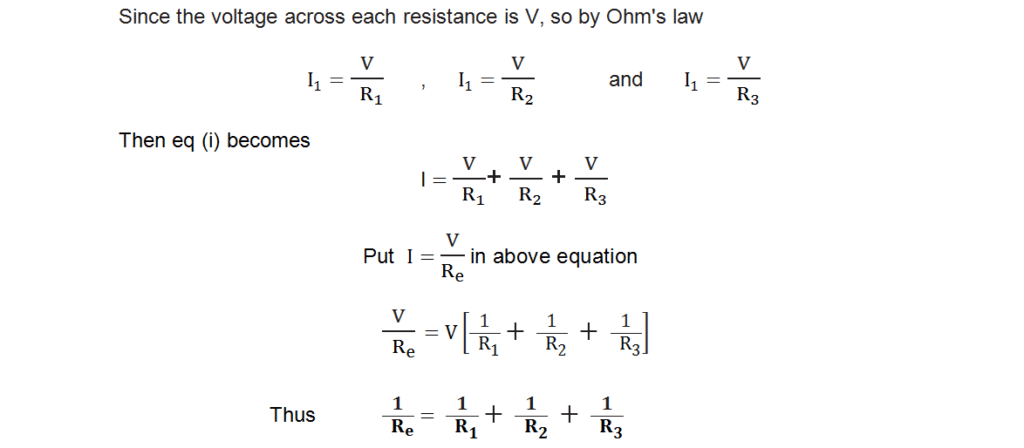
Q3. b. Water waves in a shallow dish are 6.0 cm long. At one point, the water moves up and down at a rate of 4.8 oscillations per second. (2+2)
i) What is the speed of the water waves?
ii) What is the period of the water waves?
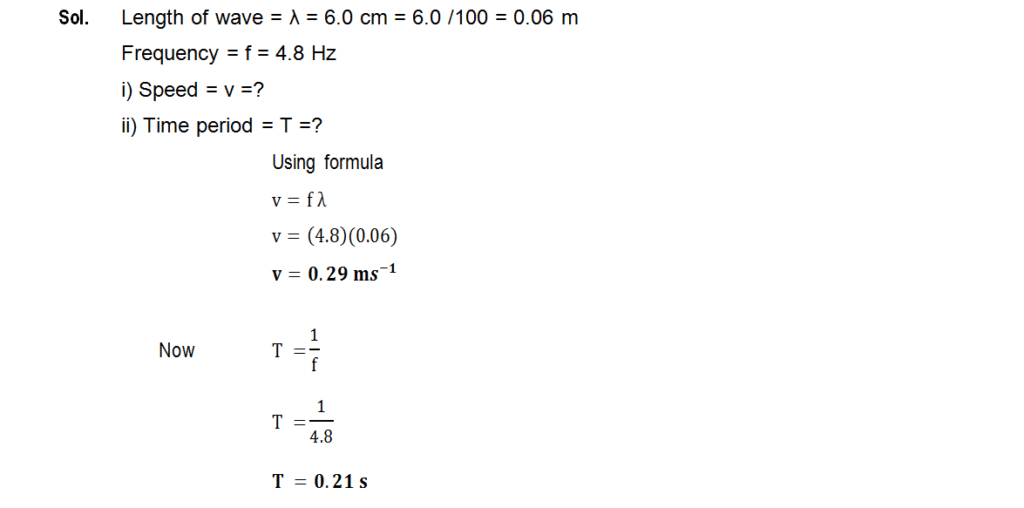
Q4. a. Explain a simple microscope with a neat and clean diagram. Also, give details of its magnifying power and resolving power. (3+2+1)
Excluded from Syllabus for Annual Exam 2021
Q4. b. A power station generates 500MW of electrical power which is fed to a transmission line. What current would flow in the transmission line if the input voltage is 250kV? (4)
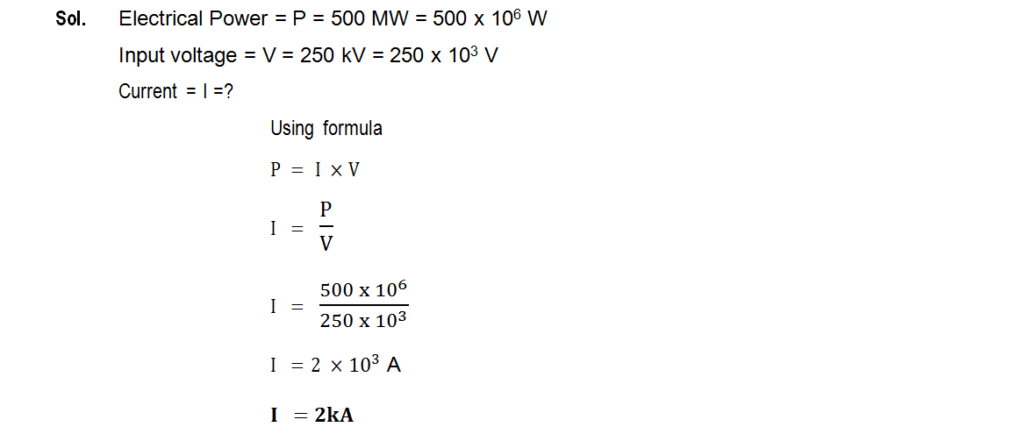
Q5. a. Explain nuclear fission with diagram and nuclear equation. What is a nuclear fission chain reaction and for what purpose its controlled and uncontrolled types are used. (6)
Ans. Nuclear Fission Reaction:
A process in which a heavy nucleus breaks into two nearly equal parts with the release of large energy is called nuclear fission.
Nuclear fission takes place when a heavy nucleus, such as U-235, splits, or fissions, into two smaller nuclei by absorbing a slow-moving (low-energy) neutron.

Where is U-236 an intermediate state that lasts only for a fraction of a second before splitting into nuclei X and Y, called fission fragments.
Fission Chain Reaction: When a neuron reacts with a uranium nucleus, two or three neutrons are released. Every one of these neutrons reacts with the next nuclei producing two or three more neutrons and hence the number of available neutrons and the fission goes on increasing. Such a reaction is called a chain reaction.

Controlled Fission Chain Reaction:
When extra neutrons liberated in fission reactions are absorbed using some material to slow down the chain reaction, the reaction is called a controlled fission chain reaction. This type of reaction is self-sustained and used in nuclear reactors. A nuclear reactor provides energy for useful purposes.
Uncontrolled Fission Chain Reaction:
Calculations show that if the chain reaction is not controlled, it will proceed too rapidly and possibly results in the sudden release of an enormous amount of energy (an explosion). This type of reaction is used in Atomic bombs.
Q5. b. Explain the working of a cathode ray oscilloscope (CRO). What is a function of an electron gun, deflecting plates, and fluorescent screen in it? (2+2)
Out of Syllabus for Annual Exam 2021



